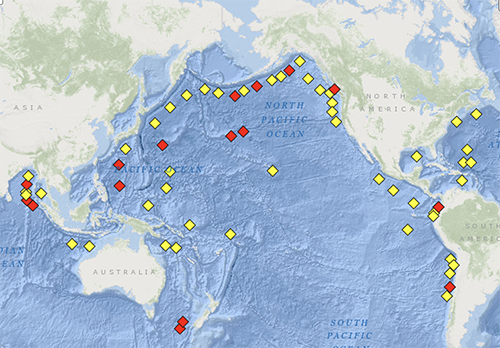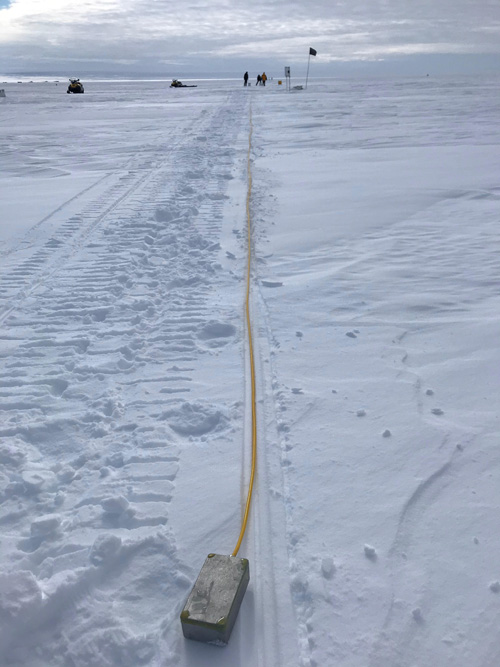From The University of Michigan
2.13.24
Morgan Sherburne

Fiber optic cables that line ocean floors could provide a less expensive, more comprehensive alternative to the current buoys that act as early warning systems for tsunamis, says a University of Michigan researcher.
A system called DART, or Deep-ocean Assessment and Reporting of Tsunamis, is composed of specialized buoys that monitor for tsunamis.

Map at Interactive map at National Data Buoy Center
Overseen by the National Oceanic and Atmospheric Administration, the buoys cost about $500,000 to install, with another $300,000 annually for upkeep. Thirty-two detection buoys dot the perimeter of the Pacific Ocean, resulting in millions of dollars per year in upkeep—costly, but vital upkeep.
Now, U-M seismologist Zack Spica and colleagues at California Institute of Technology have used a technique called distributed acoustic sensing, or “DAS”, to tap into a cheaper, more ubiquitous way to keep tabs on the natural disasters: the roughly 1 million miles of fiber optic cables that crisscross ocean floors.
“Telecommunication companies have been laying down these fiber optic cables for the last 30 years, and have spent hundreds of billions of dollars to do that,” said Spica, U-M assistant professor of earth and environmental sciences. “Now, thanks to advanced photonics and great computing power, we can turn fiber optic cables into super dense, high fidelity arrays of sensors.”
Tsunamis are a series of massive waves triggered by sudden displacement of ocean water, most typically caused by the sudden ground motion of the sea floor. Tsunamis can be minor, or they can be devastating, such as 2004’s Indian Ocean tsunami, which killed nearly 228,000 people.
In a study published in Geophysical Research Letters, Spica and colleagues show that fiber optic cables can be used as an early tsunami warning system.
“Unlike earthquakes that happen suddenly and are hardly avoidable, even though some early warning systems exist, tsunamis generally take more time to build up and reach the coast,” Spica said. “This means that early warning systems are more efficient for tsunamis. Yet, what is hard is to assess the magnitude of a tsunami before it reaches the coast. Therefore, offshore instrumentation is needed, which is costly and hard to maintain.”
Over the previous five years, Spica and his fellow researchers installed DAS interrogator units in fiber optic telecommunication companies in Alaska, Japan, Spain and Lake Ontario that tap into underwater fiber optic cables. Using one of the devices placed in Florence, Oregon, the team was able to detect a tsunami that originated in an island chain nearly 1,300 miles east of the tip of South America.
“This was a major earthquake in the Sandwich Islands that generated a large tsunami. It wasn’t even in the same ocean as the cable and device on which we detected it,” Spica said. “By the time the tsunami arrived in Oregon and Alaska, it had a run-off of only a few centimeters, which didn’t produce any damage.”
The DAS technique works by monitoring photons—particles of light—that travel through fiber optic cables. As light travels in a wave through the cables, some photons are refracted back to the beginning of the cable. These photons are refracted backward and at a given time, the amount of light that returns to the interrogator is proportional to the deformation along the cable.
Researchers initially used these cables to detect earthquakes. Earthquakes release a massive amount of energy in a very short amount of time. The big question, Spica said, was whether the cables could detect the much more subtle movement of tsunamis. The period between the crest of waves in a tsunami can be incredibly long—up to tens of minutes and several miles between the crest of waves.
“Earthquakes generally have much higher energy and shake very quickly, while tsunamis have very broad waves,” Spica said. “So the question was, can we use these techniques to monitor very long period waves?”
The researchers are unsure what characteristic of the tsunami causes a change in the fiber optic cables. Pressure-induced deformation from extra water on top of the cables could cause fibers within them to stretch, changing how photons are refracted. Temperature could cause a similar change, but Spica says more research is needed to determine exactly how the fibers are impacted.
The DAS system could offer telecommunication companies an alternate way of using fiber optic cables in the future, as satellites replace cables as a primary route of delivering internet. Spica says the cables could be used for military surveillance, boat tracking, measuring internal waves, tracking ocean temperatures and for research on climate change.
“These telecommunication companies have heard about this sensing, but it’s still very early,” Spica said. “But if we think large, if we think big over the next 15 years, they should probably try to reinvest in their own infrastructure.”
This study builds on previous research Spica conducted to determine whether fiber optics could detect ground motions from earthquakes. Next, Spica says software needs to be developed to transcribe information for tsunami detection from fiber optic cables in real time.
See the full article here .
Comments are invited and will be appreciated, especially if the reader finds any errors which I can correct. Use “Reply” at the bottom of the post.

five-ways-keep-your-child-safe-school-shootings
Please support STEM education in your local school system
The University of Michigan is a public research university located in Ann Arbor, Michigan, United States. Originally, founded in 1817 in Detroit as the “Catholepistemiad”, or “University of Michigania”, 20 years before the Michigan Territory officially became a state, the University of Michigan is the state’s oldest university. The university moved to Ann Arbor in 1837 onto 40 acres (16 ha) of what is now known as Central Campus. Since its establishment in Ann Arbor, the university campus has expanded to include more than 584 major buildings with a combined area of more than 34 million gross square feet (781 acres or 3.16 km²), and has two satellite campuses located in Flint and Dearborn. The University was one of the founding members of the Association of American Universities.
Considered one of the foremost research universities in the United States, the university has very high research activity and its comprehensive graduate program offers doctoral degrees in the humanities, social sciences, and STEM fields (Science, Technology, Engineering and Mathematics) as well as professional degrees in business, medicine, law, pharmacy, nursing, social work and dentistry. Michigan’s body of living alumni comprises more than 500,000. Besides academic life, Michigan’s athletic teams compete in Division I of the NCAA and are collectively known as the Wolverines. They are members of the Big Ten Conference.
MacArthur “genius award” winners (alumni winners and faculty winners), Nobel Prize winners, Turing Award winners, Fields Medalists and Mitchell Scholars have been affiliated with the university. Its alumni include heads of state or government, including President of the United States Gerald Ford; cabinet-level officials; and living billionaires. It also has many alumni who are Fulbright Scholars and MacArthur Fellows.
Research
Michigan is one of the founding members (in the year 1900) of the Association of American Universities. With over 6,200 faculty members, many of whom are members of the National Academy and hold an endowed chair in their discipline, the university manages one of the largest annual collegiate research budgets of any university in the United States. U-M has a technology transfer office, which is the university conduit between laboratory research and corporate commercialization interests.
In 2009, the university signed an agreement to purchase a facility formerly owned by Pfizer. The acquisition includes over 170 acres (0.69 km^2) of property, and 30 major buildings comprising roughly 1,600,000 square feet (150,000 m^2) of wet laboratory space, and 400,000 square feet (37,000 m^2) of administrative space. At the time of the agreement, the university’s intentions for the space were not set, but the expectation was that the new space would allow the university to ramp up its research and ultimately employ in excess of 2,000 people.
The university is also a major contributor to the medical field with the EKG and the gastroscope. The university’s 13,000-acre (53 km^2) biological station in the Northern Lower Peninsula of Michigan is one of only 47 Biosphere Reserves in the United States.
In the mid-1960s U-M researchers worked with IBM to develop a new virtual memory architectural model that became part of IBM’s Model 360/67 mainframe computer (the 360/67 was initially dubbed the 360/65M where the “M” stood for Michigan). The Michigan Terminal System (MTS), an early time-sharing computer operating system developed at U-M, was the first system outside of IBM to use the 360/67’s virtual memory features.
U-M is home to the National Election Studies and the University of Michigan Consumer Sentiment Index. The Correlates of War project, also located at U-M, is an accumulation of scientific knowledge about war. The university is also home to major research centers in optics, reconfigurable manufacturing systems, wireless integrated microsystems, and social sciences. The University of Michigan Transportation Research Institute and the Life Sciences Institute are located at the university. The Institute for Social Research (ISR), the nation’s longest-standing laboratory for interdisciplinary research in the social sciences, is home to the Survey Research Center, Research Center for Group Dynamics, Center for Political Studies, Population Studies Center, and Inter-Consortium for Political and Social Research. Undergraduate students are able to participate in various research projects through the Undergraduate Research Opportunity Program (UROP) as well as the UROP/Creative-Programs.
The U-M library system comprises nineteen individual libraries with twenty-four separate collections—roughly 13.3 million volumes. U-M was the original home of the JSTOR database, which contains about 750,000 digitized pages from the entire pre-1990 backfile of ten journals of history and economics, and has initiated a book digitization program in collaboration with Google. The University of Michigan Press is also a part of the U-M library system.
In the late 1960s U-M, together with Michigan State University and Wayne State University, founded the Merit Network, one of the first university computer networks. The Merit Network was then and remains today administratively hosted by U-M. Another major contribution took place in 1987 when a proposal submitted by the Merit Network together with its partners IBM, MCI, and the State of Michigan won a national competition to upgrade and expand the National Science Foundation Network (NSFNET) backbone from 56,000 to 1.5 million, and later to 45 million bits per second. In 2006, U-M joined with Michigan State University and Wayne State University to create the the University Research Corridor. This effort was undertaken to highlight the capabilities of the state’s three leading research institutions and drive the transformation of Michigan’s economy. The three universities are electronically interconnected via the Michigan LambdaRail (MiLR, pronounced ‘MY-lar’), a high-speed data network providing 10 Gbit/s connections between the three university campuses and other national and international network connection points in Chicago.



































